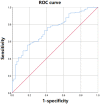The Predictive Role of Lymphocyte-to-Monocyte Ratio in Acute Kidney Injury in Acute Debakey Type I Aortic Dissection
- PMID: 34458315
- PMCID: PMC8384963
- DOI: 10.3389/fsurg.2021.704345
The Predictive Role of Lymphocyte-to-Monocyte Ratio in Acute Kidney Injury in Acute Debakey Type I Aortic Dissection
Abstract
Background: The post-operative acute kidney injury (AKI) represents a common complication in the Acute Debakey Type I Aortic Dissection (ADTIAD) and predicts a poorer prognosis. The clinical evidence is scarce supporting the predictive value of the pre-operative lymphocyte-to-monocyte ratio (LMR) in post-operative AKI in ADTIAD. Methods: In this retrospective cohort study, 190 consecutive patients with ADTIAD enrolled for surgical treatment between January 1, 2013, and December 31, 2018. The diagnosis of AKI followed the Kidney Disease: Improving Global Outcomes guidelines (KDIGO). Pre-operative LMR and other possible risk factors were analyzed for their prognostic value in the post-operative AKI in ADTIAD. Results: The subjects were assigned to the low-LMR and high-LMR groups according to the median value of pre-operative LMR. For post-operative AKI, the incidence and the severity in the low-LMR group were statistically different from that of the high-LMR group. Besides, the lower LMR was statistically associated with the more extended ICU stay and intubation time and higher incidences of ischemic stroke and in-hospital mortality. Additionally, in the multivariable analysis, the pre-operative LMR was an independent predictor for post-operative AKI in ADTIAD. A predictive model for post-operative AKI in ADTIAD was established incorporating LMR. Conclusions: LMR is an independent prognostic indicator incorporated into the predictive model with other risk factors to predict the post-operative AKI in ADTIAD.
Keywords: acute Debakey type I aortic dissection; acute kidney injury; lymphocyte-to-monocyte ratio; predictive model; risk factor.
Copyright © 2021 Ma, Chen, Yun, Zhao, Li, Wu, Liu, Shen, Ma, Wang, Zou and Zhang.
Conflict of interest statement
The authors declare that the research was conducted in the absence of any commercial or financial relationships that could be construed as a potential conflict of interest.
Figures



References
-
- Zhang Q, Ma X, Zhang W, Wang Z, Zhang H, Zhang X, et al. . Surgical repair and reconstruction of aortic arch in debakey type I aortic dissection: recent advances and single-center experience in the application of branched stent graft. J Cardiothorac Surg. (2017) 12:86. 10.1186/s13019-017-0649-6 - DOI - PMC - PubMed
LinkOut - more resources
Full Text Sources

